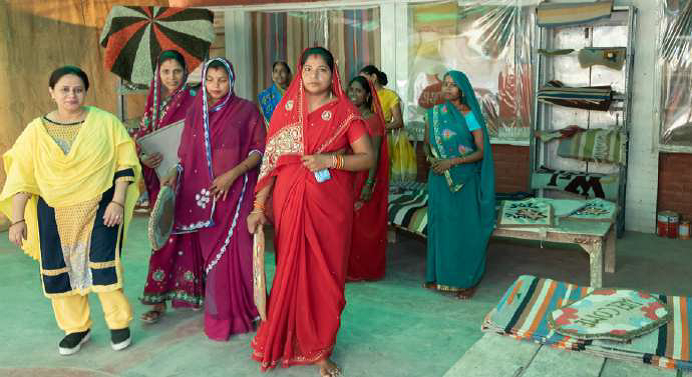Rugged Charm
Punja weaving forms part of India's glorious weaving traditions. It is a time-tested and long-used method of flooring in India. The Durrie is a small carpet or rug woven by women in rural areas on two parallel bars of looms and found to be commonly used in the villages. Patterns are based on contemporary designs, which are geometric, floral or a play of colors .The weaving technique produces weft-faced design in a durrie, in which the warp is made of cotton yarn, and the weft is made of wool yarn. The tensile strength of cotton yarn in the warp, provides a strong foundation to the rug. A claw-like device, called Punja is used by the weavers to densely pack the weft yarn to almost hide the warp hence the name. Punja Durrie is a GI product of Mirzapur.
Activity
Production of Punja Dari in Mirzapur, UP
Nature of Intervention
Khwaja Garib Nawaj Prabodhini Mahila SHG comprising of 10 members was promoted by Mahila Prabodhini Foundation (MPF), Mirzapur in 2014 under WSHG scheme. A 10 days' training on skill development under LEDP involving grant assistance of of Rs.5 lakh was organised for 10 members of Khwaja Garib Nawaj Prabodhini Mahila by MPF. An exposure visit to various production units in Bhadohi and Jaunpur was taken up. A refresher training on designing the product had also been arranged. Apart from various types of training, the group was provided with hand holding support for production and marketing of product. Raw materials were procured locally and NGO had tie-up arrangement with several agencies in the carpet industry. Due to the awareness among the SHG members, they were able to directly sell the finished product to various firms/outlets. A loan of Rs.0.50 lakh was received from Allahabad UPGB.
The Impact
Income - Rs. 3000 per member / month
The women could now weave around 4-5 Punja Durrie and 10-12 mats per month. They are very confident and the level of social empowerment has also gone up by several notches. This activity is a source of supplementary income to poor households and has neverending demand with enough market opportunities for the product. The rural women are eager to engage in such income generating activities which do not demand them to compromise with their household responsibilities.

Critical Determinants
- Advance training on existing skill
- Exposure visit and handholding by the NGO.
- Loan for taking up the activity
Source : Creating Livelihoods, Changing Lives
Last Modified : 7/24/2023
This topic provides information about A Clean Swee...
This topic provides information about Luminous Liv...
The topic deals with aspects related to microfinan...
This topic provides information about All in a Day...
